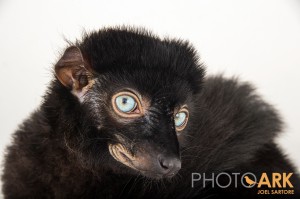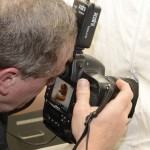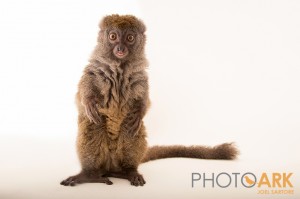
Presley the blue-eyed black lemur peers into the camera during a portrait session with National Geographic photographer Joel Sartore. Blue-eyed black lemurs are the only primate species besides humans to have truly blue eyes. Photo by Joel Sartore. ©PhotoArk.com
June 20, 2014 — Lemurs don’t sit still for portraits. They sniff the lights. They scent mark the camera lens. They relieve themselves in the middle of the photo shoot. But that doesn’t faze National Geographic photographer Joel Sartore, whose latest lemur photos — taken at the Duke Lemur Center — are now available for viewing.
For more than seven years, Sartore has been visiting zoos and captive breeding facilities across the country on a mission to photograph the Earth’s endangered animals. Using black and white backgrounds and studio lighting, Sartore is building a portrait archive called the Photo Ark . His goal is to capture as many of the 6000 species held in American zoos and private collections as he can before they disappear. Since he started he has visited over 180 sites and photographed more than 3700 species – some of which are no longer found in the wild.

Joel Sartore pokes his camera lens through an opening in the pop-up tent that serves as his portable portrait studio. Just visible on the viewfinder is Poots, a female blue-eyed black lemur. Males are solid black; females are reddish-brown. Photo by David Haring.
One of his first subjects at the Duke Lemur Center was a blue-eyed black lemur named Presley. Perched on a stool, Sartore poked his camera lens through a three-inch slit in the pop-up tent that serves as Sartore’s portable portrait studio. Presley’s handler fed him a Craisin through the tent’s zippered wall to coax the lemur away from the camera, which Presley was intent on sniffing.
“My camera gets pooped and peed on a lot,” Sartore said.
Presley represents one of 17 lemur species at the Duke Lemur Center, which houses 250 animals — the largest collection of lemurs outside their native home of Madagascar.
Lemurs are some of the most threatened animals Sartore has photographed, but they’re far from the only animals on his list — his Photo Ark gallery runs from beetles to rhinos and everything in between.
Sartore photographed a total of six animals during his visit to Durham. Buckwheat the mouse lemur, Poots the blue-eyed black lemur, Osprey the fat-tailed dwarf lemur, Iroquois the red-bellied lemur and Beeper the bamboo lemur all had a turn under the lights.

Beeper the bamboo lemur stands up to get a better look at the camera. Photo by Joel Sartore. ©PhotoArk.com
Beeper was dubbed the best poser of the day. “She has a lot of personality packed in a little body,” said primate technician Bevan Clark. “She was really working it.”
Each technician who helped out with the shoot received a signed, archival print of the animal they helped with. See more animal portraits and learn how you can support the Photo Ark project at http://photoark.com/.

